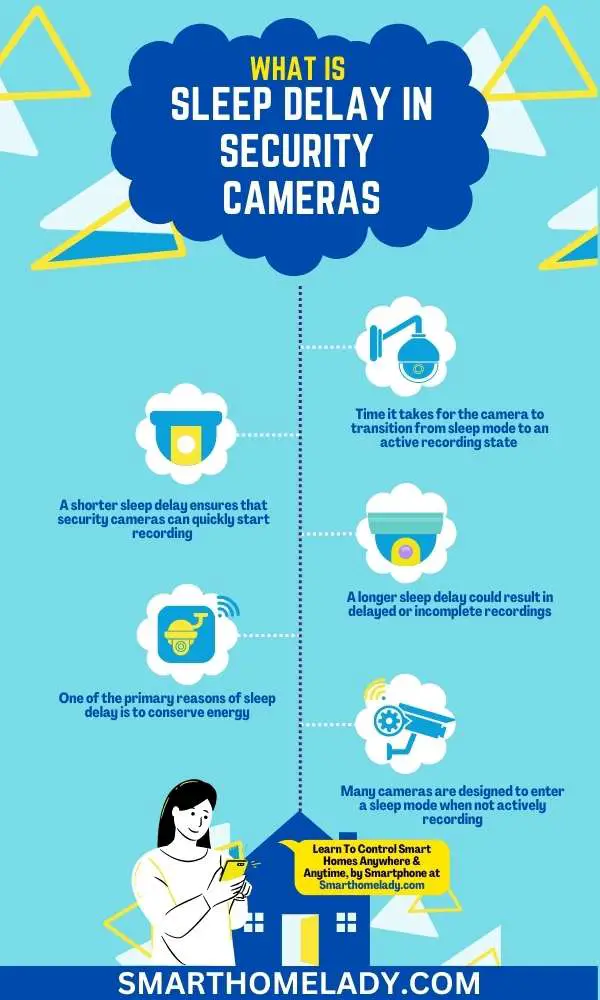Have you ever wondered why security camera footage sometimes appears to be a few seconds behind real-time events? Well, my friend, that’s what we call sleep delay.
In the world of security cameras, sleep delay refers to the time it takes for a camera to wake up and start recording after it detects motion.
This brief lag can make a huge difference when capturing crucial moments, especially in high-stakes situations where every second counts.
So, let’s dive deeper into this fascinating topic and explore what is sleep delay on security cameras. We’ll also discuss the factors that contribute to sleep delay and its implications for security systems.

Contents
- 1 What is Sleep Delay on Security Camera? Why It Happens?
- 2 Reasons & Factors Affecting Sleep Delay On Security Cameras
- 3 How Does Sleep Delay On Security Cameras Work?
- 4 Importance Of Sleep Delay In Security Cameras?
- 5 2 Types Of Sleep Delay On Security Cameras
- 6 How To Prevent Sleep Delay On Security Cameras?
- 7 Do all security cameras have a delay?
- 8 What security camera has no delay?
- 9 Why do cameras lag at night?
- 10 Do security cameras work well at night?
- 11 What is the latency of a camera?
- 12 Do wired cameras have a lag?
- 13 Conclusion
What is Sleep Delay on Security Camera? Why It Happens?
Sleep delay on security cameras refers to the time it takes for the camera to transition from sleep mode to an active recording state upon detecting motion or an event.
It is a crucial factor in determining the effectiveness of a security system’s response time.
A shorter sleep delay ensures that security cameras can quickly start recording and capturing footage when needed, minimizing the risk of missing critical events.
It is particularly important in scenarios where immediate action may be required, such as in the case of intrusions or emergencies.
A longer sleep delay could result in delayed or incomplete recordings, potentially compromising the security of the premises. Therefore, minimizing sleep delay is essential in maintaining a prompt and efficient surveillance system.
Must Read
- How Far Can Security Cameras See?
- Why Do Security Cameras Have Green Lights? Reasons
- Can Security Cameras Record Audio?
Reasons & Factors Affecting Sleep Delay On Security Cameras
Sleep delay on security cameras is a common issue, and it can happen for various reasons.
One of the primary reasons is to conserve energy. Think of it this way: security cameras are like vigilant sentinels, constantly scanning their surroundings for any signs of movement.
However, if they were to record without any breaks continuously, they would consume a significant amount of power, quickly draining their batteries.
To avoid this, many cameras are designed to enter a sleep mode when not actively recording, only waking up when they detect motion or receive a triggering signal.
This sleep delay can vary depending on several factors, including the camera’s make and model, its settings, and the overall efficiency of the system.
- Power consumption, motion detection settings, and night vision capabilities all play an important role in determining whether or not sleep delay will occur.
- Additionally, camera placement and installation costs can impact the occurrence of sleep delay.
- As such, it’s important to consider all these factors when installing a security camera system to ensure the best performance with minimal sleep delay.
Some cameras may take just a fraction of a second to wake up and start recording, while others might experience delays of several seconds or even more.
It’s important to note that while sleep delay can be advantageous in terms of power management, it can also be a potential drawback, especially in situations where immediate and real-time monitoring is crucial.
Must Read: Do Security Cameras Record All The Time?
How Does Sleep Delay On Security Cameras Work?
Regarding home security, a Sleep Delay feature can be a valuable tool for providing increased protection.
It works by using power management technology to detect motion and false alarms while reducing energy consumption and extending battery life.
This is done by activating the camera after a certain time period has passed since the last motion was detected or a false alarm was triggered.
The sleep delay feature prevents the camera from continually searching for activity, which helps conserve the battery power of the device.
Some cameras may also have settings that allow you to adjust how long your Sleep Delay will last, offering even more control over how much energy is being used in order to preserve battery life.
Importance Of Sleep Delay In Security Cameras?
Having a Sleep Delay feature in your security camera is essential for ensuring that you get the most out of your home security system.
- The Sleep Delay feature sets the motion sensitivity, time-lapse, and night vision settings of the camera to ensure maximum security when you are away from home or asleep.
- It also helps to extend battery life by limiting how often the camera records or takes pictures.
- Additionally, it can be programmed to work with other features like automated lighting systems, which can be used as another level of security for your property.
- By setting up and using Sleep Delay properly on your security cameras, you are sure to get the best protection possible for your home and family.
Must Read: What Happens If You Unplug A Security Camera?
2 Types Of Sleep Delay On Security Cameras
I will discuss the different types of sleep delay on security cameras here.
1. Video Delays
First, there’s a video delay. This occurs when the camera takes a few seconds to start recording after it detects motion. It can be useful in some cases, as it allows you to avoid recording too much unnecessary footage.
I, as a security professional, know that a security camera’s video delay can be enough to make a difference when it comes to monitoring activity. This is why it’s essential for us to understand the various ways we can control and adjust the delay of our cameras.
We need to take into consideration motion detection settings, power-saving features, alarm settings, heat sensors, and other security protocols when setting up our cameras.
2. PIR (Passive Infrared) Delay
Then there’s PIR (Passive Infrared) delay. This happens when the camera waits for an infrared signal before starting to record.
It can be beneficial in more sensitive areas where false alarms need to be avoided.
This is especially beneficial for cameras placed in areas with limited lighting, as they can still pick up on movement despite the lack of light.
The camera’s motion sensitivity can be adjusted depending on how much activity you want it to detect, and its placement will also affect how much area it can monitor effectively.
With this feature in place, you can rest assured knowing that any suspicious activity will be quickly noticed and reported back to you without having to worry about false alarms or missed moments.
How To Prevent Sleep Delay On Security Cameras?
You can prevent sleep delay on security cameras by setting them to record at regular intervals.
To ensure reliable surveillance, it is important to configure the settings correctly and maintain a constant power source.
Alarm sensitivity, temperature sensors, motion detection, and wireless connections should all be taken into consideration when configuring the camera’s settings.
For example, if the alarm sensitivity is set too high, false alarms may be triggered.
| Features | Benefits |
|---|---|
| Alarm Sensitivity | Prevent False Alarms |
| Temperature Sensors | Ensure Optimal Image Quality |
| Motion Detection | Ensure Proper Recording Timeframes |
| Power Sources | Maintain Low Power Consumption |
| Wireless Connections | Minimize Lag Time & Dropped Frames |
Do all security cameras have a delay?
Not all security cameras are the same, so you’ll want to check if yours has a delay before investing in one.
Security cameras can have different levels of sleep delays, which depend on factors such as motion detection, firmware updates, network connection, battery life, and illumination levels.
- Firmware updates help keep your device up-to-date with features that can improve performance and reduce sleep delay time.
- Network connections provide real-time data transmission between the camera and your computer or other device for monitoring purposes.
- Battery life is also important since low battery power can cause the camera to go into sleep mode earlier than expected.
- Finally, illumination levels can affect how quickly a camera enters sleep mode due to its sensitivity thresholds for darkness and brightness.
All these factors should be considered when looking at security cameras with potential sleep delays.
Must Read: Security Cameras That Work When Power Goes Out?
Frequently Asked Questions FAQs
What security camera has no delay?
There are several security cameras available in the market that offer minimal to no delay in live video streaming.
One such example is the Arlo Pro 3 wireless camera. This camera uses advanced technology to provide real-time footage with minimal latency.
With its high-speed internet connectivity and efficient processing capabilities, the Arlo Pro 3 ensures you can monitor your surroundings without any noticeable delay.
Additionally, some professional-grade IP cameras, like those used in commercial surveillance systems, are designed to have extremely low latency to provide instantaneous video feedback.
Why do cameras lag at night?
Cameras often experience lag or reduced performance at night due to various factors.
One primary reason is the lower levels of light available during nighttime, which can affect the camera’s image sensor.
Most cameras rely on ambient light or artificial lighting sources to capture clear and detailed footage.
In low light conditions, the camera’s sensor may struggle to capture enough light, resulting in grainy or blurry images and slower processing speeds.
However, many modern security cameras are equipped with infrared (IR) night vision technology, which uses infrared light to illuminate the area, allowing the camera to capture high-quality footage even in complete darkness.
Do security cameras work well at night?
Yes, security cameras are specifically designed to work effectively at night. With the advancements in technology, most security cameras now come equipped with night vision capabilities.
These cameras use infrared light or other low-light enhancement technologies to capture clear and detailed footage in low-light conditions.
Whether you are monitoring your home, office, or any other premises, modern security cameras can provide reliable surveillance even during the darkest hours.
However, it is essential to ensure that your camera has adequate night vision range and resolution to meet your specific requirements.
What is the latency of a camera?
The latency of a camera refers to the delay between the occurrence of an event and the time it takes for the camera to capture and transmit the corresponding video footage.
Different cameras can have varying levels of latency, depending on their technology and specifications.
For example, high-quality IP cameras designed for professional surveillance purposes typically have very low latency, often as low as a few milliseconds.
On the other hand, consumer-grade cameras or those with wireless connections may have slightly higher latency due to factors like data transmission and processing speed.
It is crucial to consider the intended use and requirements of your surveillance system when choosing a camera with an acceptable latency level.
Do wired cameras have a lag?
Wired cameras generally have significantly lower lag compared to wireless cameras.
Since wired cameras directly connect to the recording device or network via physical cables, they can transmit video data with minimal delay.
This direct connection ensures a stable and consistent flow of data, resulting in real-time or near-real-time video streaming.
On the other hand, wireless cameras rely on Wi-Fi or other wireless networks, which can introduce latency due to potential interference or signal strength issues.
Therefore, if low latency is a crucial factor in your surveillance system, opting for wired cameras would be a recommended choice.
Conclusion
In conclusion, sleep delay on security cameras refers to the slight lag that occurs when the camera transitions from standby mode to active recording.
This delay can vary depending on the camera’s hardware and settings, but it typically ranges from a few seconds to a minute.
While this delay may seem insignificant, it can have significant implications in terms of security. It’s important to choose security cameras that have minimal sleep delay to ensure that any suspicious activities are captured promptly.
So, whether you’re considering installing security cameras at home or researching the topic for knowledge, don’t forget to take sleep delay into account.
Sources
- A survey of visual sensor networks. Advances in multimedia. (Source Link)
- Closing the blinds: Four strategies for protecting smart home privacy from network observers. (Source Link)
- Intelligent multi-camera video surveillance system for smart city applications. (Source Link)


